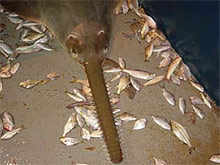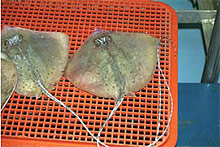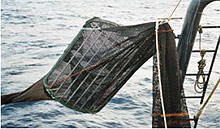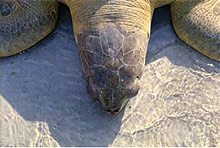
|
||||||||
|
Australia’s Northern Prawn Fishery uses turtle excluder devices (TEDs) and bycatch reduction devices (BRDs) to reduce the catch of non-commercial species (bycatch). TEDs are hard grids placed in trawl nets to prevent turtles and other large animals from becoming trapped in the nets. The grid guides turtles towards an opening in the net, through which they can escape. The commercial prawns are small enough to pass through the grid and so are still caught in the net. BRDs are changes to the trawl net itself, they have openings designed to enable smaller animals to actively swim out of the net. Both devices were made compulsory in the fishery during 2000.Bycatch in the Northern Prawn Fishery includes fish, turtles, sharks and rays, and invertebrates (crabs, non-commercial prawns and other crustacea, seaeggs, sponges and corals). The effectiveness of TEDs and BRDs in protecting these species from capture has been assessed in a study involving the CSIRO, the Australian Maritime College and Northern Prawn Fishery operators, with funding from the Fisheries Research and Development Corporation. The study combined the skills of fishers, fisheries technologists, scientists, economists, statisticians and conservationists. Scientific observers compared catches on 23 commercial vessels and a large proportion of the fleet was surveyed. |
|
Good news for turtles
“We found the effect of these devices varied widely between species groups,” said Mr David Brewer, the leader of the CSIRO Project team. “But research revealed that the impact of trawling on turtles and many of the highest risk sharks and rays has been reduced dramatically.”
 Sawfish are highly vulnerable to trawling and can be difficult to exclude using bycatch reduction devices. (courtesy CSIRO Marine and Atmospheric Research) |
The greatest bycatch reduction was recorded for turtles, whose capture was reduced from about 5500 during 1999 to less than 50 during 2000, and total deaths reduced from about 1200 to less than 12 after the introduction of TEDs and BRDs. All species of turtle are excluded. Still at risk of unintentional capture are sea snakes, sawfish and small fish, sharks and rays. “Continuous improvement in the design and use of TEDs and BRDs is critical and new devices or technologies may be needed for some species,” said Mr Brewer. “This may require a greater understanding of how prawn and fish behave when they are caught in a trawl net so BRD designs can be improved to allow fish to swim to freedom while retaining the prawns.” |
Faster handling
Mr Brewer says the exclusion of the large animals by the TEDs has made prawn catches easier to handle and sort, reduced danger to the crew and increased the value of the catch by reducing the crushing of prawns. “While catches of commercially important prawns were reduced by 3–6%, damage to prawns by heavy animals was reduced by 40%,“ he says. The Northern Prawn Fishery is one of Australia’s most valuable Commonwealth fisheries and one of the most progressive in terms of dealing with environmental issues. It covers more than one million square kilometres of ocean, from north of Weipa in Queensland to Cape Londonderry in Western Australia. This was the first major assessment of bycatch reduction practices carried out in a tropical fishery. |
 Turtle excluder devices also help to prevent the capture of large sharks and rays. (courtesy of CSIRO Marine and Atmospheric Research) |
|
Find out more
Acknowledgement This information sheet has been compiled using the expertise and support of CSIRO Marine and Atmospheric Research. We would like to acknowledge DAFF, AFMA, FRDC, CSIRO and DEH for allowing us to use their images for Seaweek 2007. |




